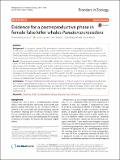Files in this item
Evidence for a postreproductive phase in female false killer whales Pseudorca crassidens
Item metadata
| dc.contributor.author | Photopoulou, Theoni | |
| dc.contributor.author | Ferreira, Ines M. | |
| dc.contributor.author | Best, Peter B. | |
| dc.contributor.author | Kasuya, Toshio | |
| dc.contributor.author | Marsh, Helene | |
| dc.date.accessioned | 2018-04-11T10:44:20Z | |
| dc.date.available | 2018-04-11T10:44:20Z | |
| dc.date.issued | 2017-06-21 | |
| dc.identifier | 252783285 | |
| dc.identifier | 5c61ddb5-7fac-4b61-9b62-c80941811c74 | |
| dc.identifier | 000403972700001 | |
| dc.identifier | 85021115944 | |
| dc.identifier.citation | Photopoulou , T , Ferreira , I M , Best , P B , Kasuya , T & Marsh , H 2017 , ' Evidence for a postreproductive phase in female false killer whales Pseudorca crassidens ' , Frontiers in Zoology , vol. 14 , 30 . https://doi.org/10.1186/s12983-017-0208-y | en |
| dc.identifier.issn | 1742-9994 | |
| dc.identifier.other | ORCID: /0000-0001-9616-9940/work/44748888 | |
| dc.identifier.uri | https://hdl.handle.net/10023/13115 | |
| dc.description | This research was supported by the Nature Conservation Society of Japan and US Marine Mammal Commission and in part by the National Research Foundation of South Africa (Grant Number 90782). TP was supported by a Scarce Skills Postdoctoral Research Fellowship from the National Research Foundation, South Africa during part of the time spent working on this manuscript. Financial support for the work in Japan was provided by the World Wide Fund for Nature, Japan, and in South Africa by a grant to PBB from the National Research Foundation, South Africa. | en |
| dc.description.abstract | Background: A substantial period of life after reproduction ends, known as postreproductive lifespan (PRLS), is at odds with classical life history theory and its causes and mechanisms have puzzled evolutionary biologists for decades. Prolonged PRLS has been confirmed in only two non-human mammals, both odontocete cetaceans in the family Delphinidae. We investigate the evidence for PRLS in a third species, the false killer whale, Pseudorca crassidens, using a quantitative measure of PRLS and morphological evidence from reproductive tissues. Results: We examined specimens from false killer whales from combined strandings (South Africa, 1981) and harvest (Japan 1979-80) and found morphological evidence of changes in the activity of the ovaries in relation to age. Ovulation had ceased in 50% of whales over 45 years, and all whales over 55 years old had ovaries classified as postreproductive. We also calculated a measure of PRLS, known as postreproductive representation (PrR) as an indication of the effect of inter-population demographic variability. PrR for the combined sample was 0.14, whereas the mean of the simulated distribution for PrR under the null hypothesis of no PRLS was 0.02. The 99th percentile of the simulated distribution was 0.08 and no simulated value exceeded 0.13. These results suggest that PrR was convincingly different from the measures simulated under the null hypothesis. Conclusions: We found morphological and statistical evidence for PRLS in South African and Japanese pods of false killer whales, suggesting that this species is the third non-human mammal in which this phenomenon has been demonstrated in wild populations. Nonetheless, our estimate for PrR in false killer whales (0.14) is lower than the single values available for the short-finned pilot whale (0.28) and the killer whale (0.22) and is more similar to working Asian elephants (0.13). | |
| dc.format.extent | 14 | |
| dc.format.extent | 1253285 | |
| dc.language.iso | eng | |
| dc.relation.ispartof | Frontiers in Zoology | en |
| dc.subject | False killer whale | en |
| dc.subject | Postreproductive lifespan | en |
| dc.subject | Reproduction | en |
| dc.subject | Odontocete | en |
| dc.subject | QH301 Biology | en |
| dc.subject | QL Zoology | en |
| dc.subject | DAS | en |
| dc.subject.lcc | QH301 | en |
| dc.subject.lcc | QL | en |
| dc.title | Evidence for a postreproductive phase in female false killer whales Pseudorca crassidens | en |
| dc.type | Journal article | en |
| dc.contributor.institution | University of St Andrews. School of Biology | en |
| dc.contributor.institution | University of St Andrews. Centre for Research into Ecological & Environmental Modelling | en |
| dc.identifier.doi | https://doi.org/10.1186/s12983-017-0208-y | |
| dc.description.status | Peer reviewed | en |
This item appears in the following Collection(s)
Items in the St Andrews Research Repository are protected by copyright, with all rights reserved, unless otherwise indicated.

